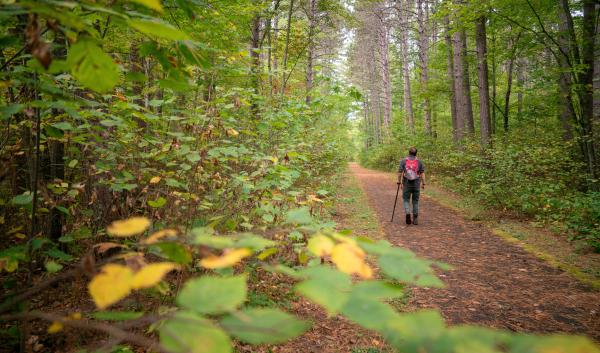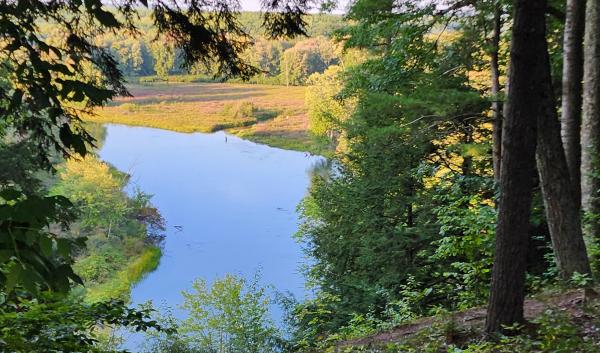This assessment synthesizes the best available scientific information on climate change and forest ecosystems. Its primary goal is to inform forest managers in the Central Appalachian region, in addition to other people who study, recreate, and live in these forests.
Forests and ecosystems in the Central Appalachians region will be affected directly and indirectly by a changing climate over the next 100 years. Understanding the potential impacts is an important first step to sustaining healthy forests in the face of changing conditions. This assessment evaluates the vulnerability of nine forest ecosystems in the Central Appalachian Broadleaf Forest-Coniferous Forest-Meadow and Eastern Broadleaf Forest Provinces of Ohio, West Virginia, and Maryland under a range of future climates. This assessment synthesizes information on the contemporary landscape, provides information on past climate trends, and describes a range of projected future climates. This information was also used to parameterize and run multiple forest impact models, which provided a range of potential tree responses to climate. Results were vetted by a multidisciplinary panel of scientists and land managers familiar with the forests of this region to assess ecosystem vulnerability through a formal consensus-based expert elicitation process. Vulnerability is described in terms of the potential impacts on a forest ecosystem and the adaptive capacity of the ecosystem. The information below is a summary of each chapter available in the vulnerability assessment. For more information and in-depth discussion please refer to the full report. This chapter describes the forests and related ecosystems across the Central Appalachian Broadleaf Forest-Coniferous Forest-Meadow and Eastern Broadleaf Forest Provinces of Ohio, West Virginia, and Maryland and summarizes current threats and management trends. This information lays the foundation for understanding how shifts in climate may contribute to changes in forest ecosystems, and how climate may interact with other stressors on the landscape. This chapter provides a brief background on climate change science, models that simulate future climate change, and forest impact models that project the effects of climate change on tree species and ecosystems. This chapter also describes the climate data used in this assessment. Many of the climatic changes that have been observed across the world over the past century are also evident in the assessment area. This chapter summarizes our current understanding of observed changes and current climate trends across the Central Appalachians region, with a focus on the last 100 years. This chapter describes climate projections for the assessment area over the 21st century. Temperature and precipitation projections are derived from downscaled simulations of climate models. Published scientific literature provides the basis for describing possible trends in a range of climate-driven processes, such as extreme weather events and snowfall. This chapter summarizes the potential impacts of climate change on forests in the assessment area, drawing on information from a coordinated series of model simulations and published research. This chapter focuses on the vulnerability of nine major forest ecosystems in the Central Appalachians region to climate change, with an emphasis on shifts in dominant tree species, features that define a system (drivers), and features that disturb a system (stressors). The adaptive capacity of each forest ecosystem was also examined as a key component to overall vulnerability. Adaptive capacity is the ability of a species or ecosystem to accommodate or cope with potential climate change impacts with minimal disruption (Glick et al. 2011, IPCC 2007).
We further rated the evidence used in assessing vulnerability as well as the level of agreement between sources of evidence. We consider a system to be vulnerable if it is at risk of a species composition change leading to a substantially different character for the forest system, or if the system is anticipated to suffer substantial declines in acreage, health, or productivity. General trends in climate change impacts and adaptive capacity factors for the Central Appalachians region are also captured in overarching synthesis statements.
This chapter summarizes the implications of potential climate change impacts on important facets of forest management and planning in the Central Appalachians region, such as impacts on wildlife or cultural resources. We point out key implications, ongoing research, and sources for more information on how climate change is expected to affect these topics. This chapter does not make recommendations as to how management should be adjusted to cope with these impacts, because impacts and responses will differ by ecosystem, ownership, and management objective. Butler, Patricia R.; Iverson, Louis R.; Thompson, Frank R., III; Brandt, Leslie A.; Handler, Stephen D.; Janowiak, Maria K.; Shannon, P. Danielle; Swanston, Christopher W.; Karriker, K.; Bartig, J.; Connolly, S.; Dijak, W.; Bearer, S.; Blatt, S.; Brandon, A.; Byers, E.; Coon, C.; Culbreth, T.; Daly, J.; Dorsey, W.; Ede, D.; Euler, C.; Gillies, N.; Hix, D.M.; Johnson, Catherine; Lyte, L.; Matthews, S.; McCarthy, D.; Minney, D.; Murphy, D.; O’Dea, C.; Orwan, R.; Peters, M.; Prasad, A.; Randall, C.; Reed, J.; Sandeno, C.; Schuler, T.; Sneddon, L.; Stanley, B.; Steele, Al; Stout, S.; Swaty, R.; Teets, J.; Tomon, T.; Vanderhorst, J.; Whatley, J.; Zegre, N. 2015. Central Appalachians forest ecosystem vulnerability assessment and synthesis: a report from the Central Appalachians Climate Change Response Framework project. Gen. Tech. Rep. NRS-146. Newtown Square, PA: U.S. Department of Agriculture, Forest Service, Northern Research Station. 310 p. https://doi.org/10.2737/NRS-GTR-146
Major Findings
Download The Full Assessment
Download The Summary (4p)
View The Story Map
Overview of key findings from the Central Appalachians forest ecosystem vulnerability assessment
Details Of The Vulnerability Assessment
Potential impacts of climate change on
ecosystem drivers and stressors
Potential impacts of climate change
on forest communities
Adaptive capacity factors
How To Cite This Report
-
Climate Change Projections for Individual Tree Species
Browse climate change projections for individual tree species.
-
Northern Forests Vulnerability
Forests of the Midwest and Northeast significantly define the character, culture, and economy of this large region but face an uncertain future as the…
-
Adaptation Tools
Tools to help professionals consider the potential effects of climate change on forests, and to design actions that can help ecosystems cope under changing…




